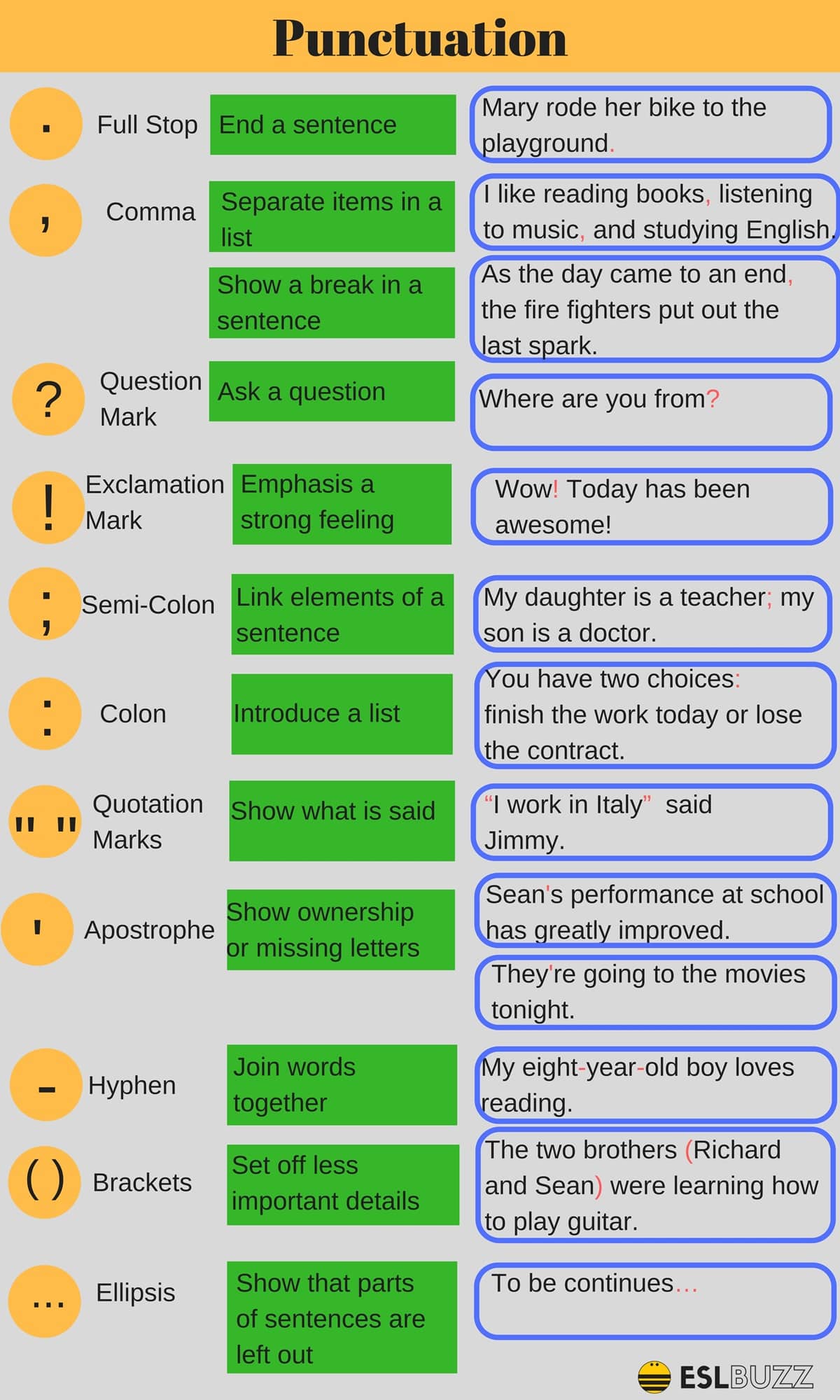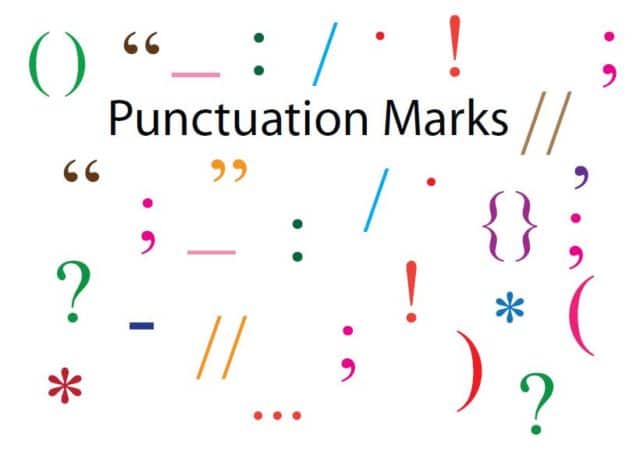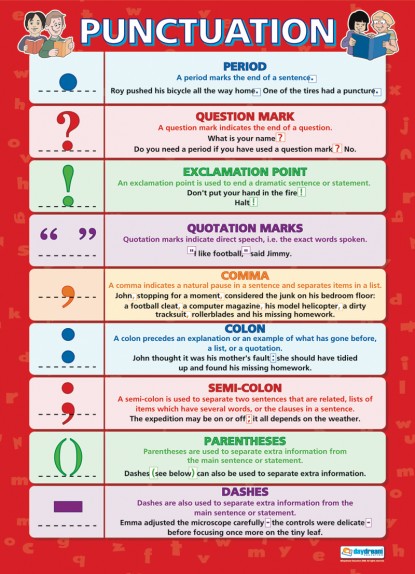Exercise: Punctuation Exercise. Put in semicolons, colons, dashes, quotation marks, Italics (use an underline), and parentheses where ever they are needed in the following sentences. The men in question Harold Keene, Jim Peterson, and Gerald Greene deserve awards. To use English punctuation correctly, remember to always capitalize the first letter of a sentence, as well as the names of specific people, places, and things. Also, make sure you end a sentence with a period unless the sentence is a question, in which case you should end it with a question mark. What this handout is about. This handout explains the most common uses of three kinds of punctuation: semicolons (;), colons (:), and dashes (—). After reading the handout, you will be better able to decide when to use these forms of punctuation in your own writing. There are 14 punctuation marks that are commonly used in English grammar. They are the period, question mark, exclamation point, comma, semicolon, colon, dash, hyphen, parentheses, brackets, braces, apostrophe, quotation marks, and ellipsis. Following their correct usage will make your writing easier to read and more appealing. What does punctuation mean? The act of punctuating; specif., the act or practice of using standardized marks in writi.
Also found in: Thesaurus, Medical, Legal, Financial, Acronyms, Encyclopedia, Wikipedia.
punctuation
punc·tu·a·tion
(pŭngk′cho͞o-ā′shən)n.1.punctuation
(ˌpʌŋktjʊˈeɪʃən) n
punc•tu•a•tion
(ˌpʌŋk tʃuˈeɪ ʃən)n.
punctuation
- em dash, en dash - The em dash is the long dash used in punctuation whose length is based on the width of the letter M; the en dash is shorter (the width of an N) and the hyphen is even shorter.
- punctual - From Latin punctum, 'point,' it can mean 'pertaining to punctuation,' or 'of or relating to a point in space.'
- square brackets, parentheses, braces - Square brackets were formerly called crotchets, round brackets are commonly called parentheses, and curly brackets are called braces; the punctuation called brackets derives from the bookshelf type, implying that, in writing, these marks 'lift up' a section of a sentence.
- stigmeology - The art of punctuation.
| Noun | 1. | punctuation - something that makes repeated and regular interruptions or divisions break, interruption - some abrupt occurrence that interrupts an ongoing activity; 'the telephone is an annoying interruption'; 'there was a break in the action when a player was hurt' |
| 2. | punctuation - the marks used to clarify meaning by indicating separation of words into sentences and clauses and phrases orthography, writing system - a method of representing the sounds of a language by written or printed symbols mark - a written or printed symbol (as for punctuation); 'his answer was just a punctuation mark' ampersand - a punctuation mark (&) used to represent conjunction (and) apostrophe - the mark (') used to indicate the omission of one or more letters from a printed word brace - either of two punctuation marks ({ or }) used to enclose textual material square bracket, bracket - either of two punctuation marks ([ or ]) used to enclose textual material angle bracket, bracket - either of two punctuation marks (`<' or=' `='>') used in computer programming and sometimes used to enclose textual material comma - a punctuation mark (,) used to indicate the separation of elements within the grammatical structure of a sentence exclamation mark, exclamation point - a punctuation mark (!) used after an exclamation hyphen, dash - a punctuation mark (-) used between parts of a compound word or between the syllables of a word when the word is divided at the end of a line of text parenthesis - either of two punctuation marks (or) used to enclose textual material full point, full stop, period, stop, point - a punctuation mark (.) placed at the end of a declarative sentence to indicate a full stop or after abbreviations; 'in England they call a period a stop' interrogation point, question mark - a punctuation mark (?) placed at the end of a sentence to indicate a question inverted comma, quotation mark, quote - a punctuation mark used to attribute the enclosed text to someone else semicolon - a punctuation mark (`;') used to connect independent clauses; indicates a closer relation than does a period separatrix, virgule, solidus, slash, diagonal, stroke - a punctuation mark (/) used to separate related items of information swung dash - a punctuation mark used in text to indicate the omission of a word | |
| 3. | punctuation - the use of certain marks to clarify meaning of written material by grouping words grammatically into sentences and clauses and phrases hyphenation - connecting syllables and words by hyphens grouping - the activity of putting things together in groups orthography, writing system - a method of representing the sounds of a language by written or printed symbols |
punctuation
[ˌpʌŋktjʊˈeɪʃən]punctuation
[ˌpʌŋktʃʊˈeɪʃən]n → ponctuationfpunctuation markPunctuation Definition
n → signem de ponctuationpunctuation
punctuation
[ˌpʌŋktjʊˈeɪʃ/ən]n (Gram) → punteggiatura, interpunzionefpunctuate
(ˈpaŋktʃueit) verb
punctuation
→ وَضْعُ عَلامَاتُ التَّرْقِيم interpunkce tegnsætningZeichensetzungστίξηpuntuación välimerkkien käyttöponctuation interpunkcijapunteggiatura 句読 구두법interpunctietegnsettinginterpunkcjapontuaçãoпунктуация interpunktion เครื่องหมายวรรคตอนnoktalama dấu chấm phẩy标点符号Want to thank TFD for its existence? Tell a friend about us, add a link to this page, or visit the webmaster's page for free fun content.
Link to this page:
Quotation marks and adjacent punctuation
Though not necessarily logical, the American rules for multiple punctuation with quotation marks are firmly established. (See here for a brief explanation of the British style.)
Commas and periods that are part of the overall sentence go inside the quotation marks, even though they aren’t part of the original quotation.
Correct“The best investments today,” according to Smith, “are commodities and emerging-market stocks.”
Incorrect“The best investments today”, according to Smith, “are commodities and emerging-market stocks”.
Unless they are part of the original quotation, all marks other than commas or periods are placed outside the quotation marks.
CorrectShe provides a thorough list of problems in her most recent article, “Misery in Paradise”; she doesn’t provide a solution.
IncorrectShe provides a thorough list of problems in her most recent article, “Misery in Paradise;” she doesn’t provide a solution.
 Correct
CorrectWasn’t it Dickens who wrote, “It was the best of times, it was the worst of times”?
IncorrectWasn’t it Dickens who wrote, “It was the best of times, it was the worst of times?”
Punctuation Meaning
For more on the proper use of multiple punctuation at the end of a sentence, see here.